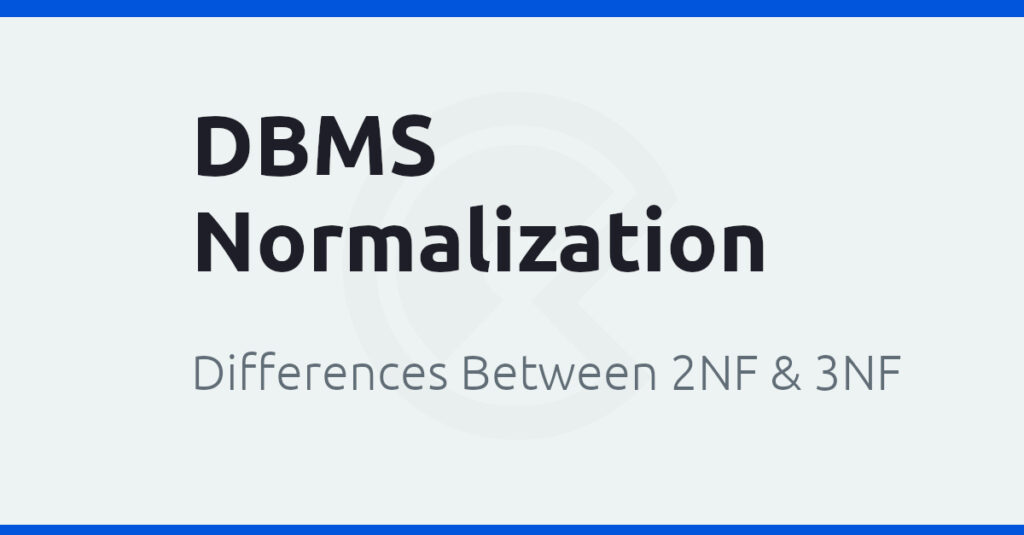Differences Between 2NF & 3NF in DBMS Normalization with Example

Both Second Normal Form (2NF) and Third Normal Form (3NF) are stages in the normalization process of relational database design. Each form addresses specific types of data redundancy and dependencies. Let’s explore the differences between 2NF and 3NF with an example:
Second Normal Form (2NF):
A table is in 2NF if it is in 1NF (no repeating groups or atomic values), and all non-prime attributes are fully functionally dependent on the entire primary key.
Example Table:
Consider a table that tracks information about courses and instructors:
| InstructorID | CourseID | InstructorName | CourseName | Department |
|---|---|---|---|---|
| 1 | 101 | John Doe | Math 101 | Mathematics |
| 1 | 102 | John Doe | Physics 201 | Physics |
| 2 | 101 | Jane Smith | Math 101 | Mathematics |
| 2 | 103 | Jane Smith | Chemistry 301 | Chemistry |
In this example, the composite key is {InstructorID, CourseID}. The table is in 1NF because all values are atomic.
However, the attribute “InstructorName” is partially dependent on the composite key {InstructorID, CourseID}. “InstructorName” depends only on “InstructorID,” not on the entire composite key.
Transformation to 2NF:
To bring the table to 2NF, we split it into two tables:
Table: Instructors
| InstructorID | InstructorName |
|---|---|
| 1 | John Doe |
| 2 | Jane Smith |
Table: Courses
| InstructorID | CourseID | CourseName | Department |
|---|---|---|---|
| 1 | 101 | Math 101 | Mathematics |
| 1 | 102 | Physics 201 | Physics |
| 2 | 101 | Math 101 | Mathematics |
| 2 | 103 | Chemistry 301 | Chemistry |
Now, “InstructorName” is fully functionally dependent on “InstructorID,” and the tables are in 2NF.
Third Normal Form (3NF):
A table is in 3NF if it is in 2NF, and there are no transitive dependencies, meaning that non-prime attributes are not dependent on other non-prime attributes.
Example Table (in 2NF):
Consider the “Courses” table from the 2NF example:
| InstructorID | CourseID | CourseName | Department |
|---|---|---|---|
| 1 | 101 | Math 101 | Mathematics |
| 1 | 102 | Physics 201 | Physics |
| 2 | 101 | Math 101 | Mathematics |
| 2 | 103 | Chemistry 301 | Chemistry |
In this table, “Department” is transitively dependent on “InstructorID” through “CourseID.”
Transformation to 3NF:
To bring the table to 3NF, we further normalize it by creating a separate table for “Departments”:
Table: Departments
| DepartmentID | Department |
|---|---|
| 1 | Math |
| 2 | Physics |
| 3 | Chemistry |
Now, the “Courses” table looks like this:
| InstructorID | CourseID | CourseName | DepartmentID |
|---|---|---|---|
| 1 | 101 | Math 101 | 1 |
| 1 | 102 | Physics 201 | 2 |
| 2 | 101 | Math 101 | 1 |
| 2 | 103 | Chemistry 301 | 3 |
The “Department” attribute is no longer transitively dependent on the composite key, and the table is in 3NF.
In summary, 2NF eliminates partial dependencies, and 3NF eliminates transitive dependencies, ensuring a more robust and normalized database structure.
# Written by Elliyas Ahmed





